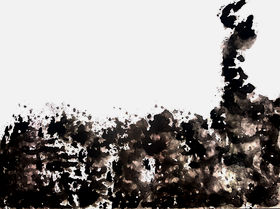Breathing, Bingdie Huang

Marine creatures breathing, the ocean breathing, humans breathing.
Do you notice the weak breath and weak pulsation of undersea creatures when enjoying the sea waves? Do you know they need oxygen as much as we do? Do you know that more than half of the oxygen we inhale is from the ocean? Do you realise an explosion of microscopic algae sucks up oxygen and chokes aquatic life, because of our behaviours, such as too much nutrition from agricultural fertilisers and sewage and over-fishing?
This short animation chooses an exaggerated way to zoom into a subtle but empathetic movement and tries to create the connection between humans and the ocean and its inhabitants: We are connected by our breathing. In addition, the project aims to make people aware that everything we do to nature has a knock-on effect on ourselves.
The Process
The most impressive moment in Kristineberg was when I petted a crab which was salvaged from the disorienting sea on a boat. I could feel its breath, my breath, and the movement of the ocean. Everything was so much in harmony. And it made me think about what else oceans might have under the smooth surface. Do they also breathe, sleep? and how? Are they also upset about the weather? Do they smile? Actually every movement of the marine creatures plays an important role in shaping the waves of the sea, together, of course, with the wind, currents and tides. I feel our ocean is not just a moving beautiful satin, it can breathe words in your ears. Therefore, I started to focus on the different breaths of marine inhabitants.

In addition, I found out about the surprising power of blue mussels and how much they filter and clean the water by their breathing. I made an experiment in which I filled two water tanks with 'surface' water, directly pumped in from the sea. The water had a slightly brown hue and sediments or detritus floating in it. In one of the tanks I put seven blue mussels. After just one hour later –I have to say I was a bit shocked about the results– the tank with mussels was entirely clean, compared to the another one. What a meaningful and ‘effective’ life. The mussels' breaths not just obtain something for themselves but make a contribution to their eco-system. Definitely, the mussels helped me to have a fresh understanding of a marine animals’ breath.
Mussels at Work: A Time Lapse Demonstration
https://www.youtube.com/watch?v=vrEyHo3SuZI&list=PLlVKgWMELGM9uhkFQhcFRwbyZP3UskRWo&index=11&t=85s
This video, Mussel Water Food, clearly explains the respiratory systems of blue mussels.
https://www.youtube.com/watch?v=7KekxV78gns&list=PLlVKgWMELGM9uhkFQhcFRwbyZP3UskRWo&index=11
After that, I tried to answer the questions I had from a scientific perspective and found out about the relationship between the breaths of the ocean and humans. And then I found research that stated that the Baltic has seven of the world's ten largest marine "dead zones" –areas where the sea's oxygen has been used up by seabed bacteria that decompose the raining mass of dead algae. The reason for the dead zones was stated to be human-induced contaminants from excess fertilisers and sewage that got into the sea. This means in these areas even the basic and necessary need of oxygen for marine organisms is being obliterated by our behaviours. Would you consider a moment or period where you cannot breathe? Have you ever thought about living in a situation where you cannot get enough air with every breath? What would you do? Unfortunately, this will not be hypotheses if we do not take action to address this issue.
I started to draw my feelings for the sea and created an short animation to convey them.
<iframe src="https://player.vimeo.com/video/402210225" width="640" height="640" frameborder="0" allow="autoplay; fullscreen" allowfullscreen></iframe>
<p><a href="https://vimeo.com/402210225">BREATHING</a> from <a href="https://vimeo.com/user108938551">Bingdie Huang</a> on <a href="https://vimeo.com">Vimeo</a>.</p>
Sources
World's Largest Dead Zone Suffocating Sea https://www.nationalgeographic.com/news/2010/3/100305-baltic-sea-algae-dead-zones-water/
Causes of Low Dissolved Oxygen and Impact to Fish
https://www.aqua-sierra.com/causes-of-low-dissolved-oxygen-and-impact-to-fish/
Save the Plankton, Breathe Freely
https://www.nationalgeographic.org/activity/save-the-plankton-breathe-freely/
Mussels stressed out by underwater noise
https://www.hw.ac.uk/news/articles/2019/mussels-stressed-out-by-underwater-noise.htm
Oxygen in the ocean
https://worldoceanreview.com/en/wor-1/ocean-chemistry/oxygen/
Dissolved oxygen
https://ozcoasts.org.au/indicators/biophysical-indicators/dissolved_oxygen/
Fact Sheet: Can changing our diets help the Baltic Sea?https://balticeye.org/en/eutrophication/fact-sheet-can-changing-our-diets-help-the-baltic-sea/
Comparative Respiratory Systems
https://slideplayer.com/slide/9502981/
How climate change alters ocean chemistry (PDF)
The ocean is losing its breath (PDF)










